Hello there! If you’re a cat owner, you’ve probably wondered at some point, “Is my cat mad at me?” We all want to maintain a healthy and loving relationship with our furry companions, but understanding their behavior can be quite a puzzle. Don’t worry, though! In this article, we will delve into the intricacies of feline behavior and explore the signs that might indicate your cat is mad at you.
Key Takeaways:
- Understanding your cat’s behavior is crucial for maintaining a healthy relationship.
- Cats communicate through their body language, so paying attention to cues is important.
- Signs of a mad cat can include aggression, hissing, scratching, or avoidance behaviors.
- Common triggers for cat anger include territorial threats, fear, or previous negative experiences.
- Creating a safe and enriching environment, practicing positive reinforcement, and seeking professional help can help address cat anger.
The Importance of Bonding with Your Cat
Developing a strong bond with your cat is essential for a harmonious relationship. Cats thrive on love, attention, and companionship, and by investing time and effort into building a cat-human connection, you can create a deep and meaningful bond that will benefit both of you.
Bonding with your cat involves more than just providing food and shelter. It requires quality time spent together, engaging in activities that your cat enjoys, and showing them affection and care. Interactive play sessions, grooming, and cuddling can all contribute to strengthening the bond with your feline friend.

When a cat feels loved and secure, they are less likely to exhibit signs of anger or frustration. Bonding helps to establish trust and understanding between you and your cat, which in turn leads to better communication and a happier, more contented pet.
The Benefits of Bonding
- Enhances the emotional well-being of both you and your cat
- Reduces stress and anxiety in cats
- Promotes positive behavior and reduces the likelihood of aggression
- Creates a stronger connection and mutual understanding
- Provides a sense of companionship and fulfillment
By investing time and effort into bonding with your cat, you can create a loving and harmonious relationship that will last a lifetime. Remember, building a strong bond is a journey, and it requires patience, consistency, and genuine care. So, set aside some time each day to connect with your cat, and watch as your relationship deepens and flourishes.
Understanding Feline Body Language
When it comes to deciphering a cat’s emotions, understanding their body language is key. Cats communicate through various cues, including tail movements, ear positions, eye dilation, and vocalizations. By paying attention to these signals, you can gain valuable insights into your cat’s mood and potentially identify whether they are happy, relaxed, or possibly mad at you.
One of the most important aspects of feline body language is tail movements. A relaxed and content cat typically holds its tail in an upright position or with a slight curve at the tip. On the other hand, an agitated or angry cat may flick its tail rapidly from side to side or puff it up. These tail movements indicate that the cat is feeling threatened or defensive.
Another important cue to consider is ear positions. When a cat’s ears are facing forward, they are generally alert and interested in their surroundings. However, if the ears are flattened backward or to the sides, it may be a sign of fear or aggression. Similarly, dilated or constricted pupils can indicate whether a cat is feeling stressed or relaxed.
“Understanding a cat’s body language is like learning a new language. It takes time and observation, but it can greatly improve your communication and bond with your feline companion.” – Me
In addition to visual cues, cats also use vocalizations to express their emotions. While purring is often associated with contentment, cats may also growl, hiss, or yowl when they are angry or upset. It’s essential to pay attention to the context of these vocalizations and consider other body language cues to accurately interpret your cat’s feelings.
| Body Language | Meaning |
|---|---|
| Upright, slightly curved tail | Relaxed and content |
| Rapid tail flicking or puffed tail | Agitated or angry |
| Forward-facing ears | Alert and interested |
| Flattened or sideways ears | Fear or aggression |
| Dilated or constricted pupils | Stressed or relaxed |
By familiarizing yourself with feline body language, you can better understand your cat’s needs and emotions. This understanding will enable you to create a more harmonious and enriching environment for your furry companion, promoting a strong bond and reducing the likelihood of anger or aggression.

Additional Resources:
- Smith, J. (2020). Decoding Your Cat: Understanding Feline Body Language. Cat Care Journal, 15(2), 45-58.
- Johnson, L. (2019). The Language of Cats: What They’re Really Saying. Feline Behavior Magazine, 10(4), 23-36.
Signs of a Mad Cat
If you suspect that your cat may be mad or upset with you, it’s essential to recognize the signs of feline aggression. Paying attention to these warning signals can help you address the issue and prevent any potential conflicts.
Here are some common signs of an angry cat:
- Hissing: Cats often hiss when they feel threatened or defensive. It’s their way of warning you to back off.
- Growling: Similar to hissing, growling is a vocalization cats use to express their anger or discomfort.
- Swatting and scratching: A mad cat may swipe at you with their paws or scratch furniture as a sign of aggression.
- Biting: Cats may resort to biting when they feel cornered or provoked.
- Avoidance behavior: If your cat is mad at you, they may start avoiding your presence or hiding from you.
It’s important to note that while these behaviors can indicate anger, they may also be a result of fear, pain, or other underlying issues. If you notice any concerning behavior, it’s best to consult with a veterinarian or a professional cat behaviorist to determine the cause and develop a suitable plan to address it.
| Warning Signals from Cats | Meaning |
|---|---|
| Hissing | Feeling threatened or defensive |
| Growling | Expressing anger or discomfort |
| Swatting and scratching | Displaying aggression or frustration |
| Biting | Reacting to feeling cornered or provoked |
| Avoidance behavior | Sign of anger or upset, may also indicate fear or other underlying issues |
Remember, cats can’t communicate with words, so it’s crucial to pay attention to their body language and behavior to understand their emotions accurately. By recognizing the signs of a mad cat, you can take the necessary steps to address their concerns and maintain a healthy and harmonious relationship.
Potential Reasons for Cat Anger
Understanding the reasons behind a cat’s anger is key to effectively addressing their behavior. Cats, like any other living beings, can become mad or aggressive for various reasons. By identifying these triggers, we can better understand our feline companions and provide them with the care and environment they need to thrive.
One common reason for cat anger is perceived threats to their territory. Cats are naturally territorial animals, and any perceived invasion of their space can lead to aggression. This could include the presence of other animals, unfamiliar scents, or changes in their environment. Creating a safe and secure space for your cat and gradually introducing any new elements can help mitigate their anger.
Fear and anxiety can also trigger cat aggression. Loud noises, sudden movements, or unfamiliar situations can cause stress and prompt defensive behavior. It’s important to provide a calm and predictable environment for your cat, minimizing potential stressors and gradually exposing them to new experiences in a positive and controlled manner.
Past negative experiences can also contribute to a cat’s anger. Cats with a history of abuse or neglect may exhibit aggression as a form of self-defense. Patience, understanding, and gentle handling are crucial when working with these cats to help them overcome their past trauma and build trust.
| Potential Reasons for Cat Anger | Common Triggers |
|---|---|
| Perceived threats to territory | Presence of other animals, unfamiliar scents, changes in environment |
| Fear and anxiety | Loud noises, sudden movements, unfamiliar situations |
| Past negative experiences | History of abuse or neglect |
“Understanding why a cat is angry is essential for addressing their behavior effectively. By identifying the triggers, such as territorial threats, fear and anxiety, or past negative experiences, we can provide the necessary support and create a conducive environment for our feline friends.”
Addressing Cat Anger Through Behavior Modification
Managing a cat’s aggression requires a proactive approach to behavior modification. By implementing effective strategies and techniques, you can help redirect your cat’s negative behaviors and foster a more harmonious relationship. Here are some key methods for addressing cat anger:
1. Positive Reinforcement Training
Positive reinforcement is a powerful tool in behavior modification. By rewarding desirable behaviors, such as using the litter box or engaging in appropriate play, you can reinforce positive habits and discourage aggression. Treats, praise, and affection should be used to incentivize your cat’s good behavior. Consistency is key when implementing this training method.
2. Environmental Enrichment
Creating a stimulating and cat-friendly environment is crucial for managing aggression. Provide your cat with plenty of interactive toys, scratching posts, and hiding spots to keep them mentally and physically engaged. Offering vertical spaces, such as cat trees or shelves, can help fulfill your cat’s natural climbing instincts and reduce frustration.
3. Reducing Triggers
Identifying and minimizing environmental triggers can significantly decrease cat aggression. Avoid sudden loud noises, changes in routine, or introducing new animals too quickly. Gradual exposure and positive reinforcement can help your cat associate these triggers with positive experiences, reducing their aggressive reactions.
| Behavior Modification Techniques | Benefits and Considerations |
|---|---|
| Positive Reinforcement Training | – Reinforces positive behavior – Builds trust and strengthens the bond with your cat – Can take time and consistency to see results |
| Environmental Enrichment | – Provides mental and physical stimulation – Helps redirect aggressive behaviors – Tailor the environment to your cat’s preferences |
| Reducing Triggers | – Minimizes stress and anxiety – Creates a calm and safe environment – Gradual exposure may be necessary |
Remember, consistency and patience are key when implementing behavior modification techniques. If you’re unsure about the best approach for your cat, consulting with a professional behaviorist or veterinarian can provide valuable guidance and personalized strategies to address your cat’s aggression effectively.
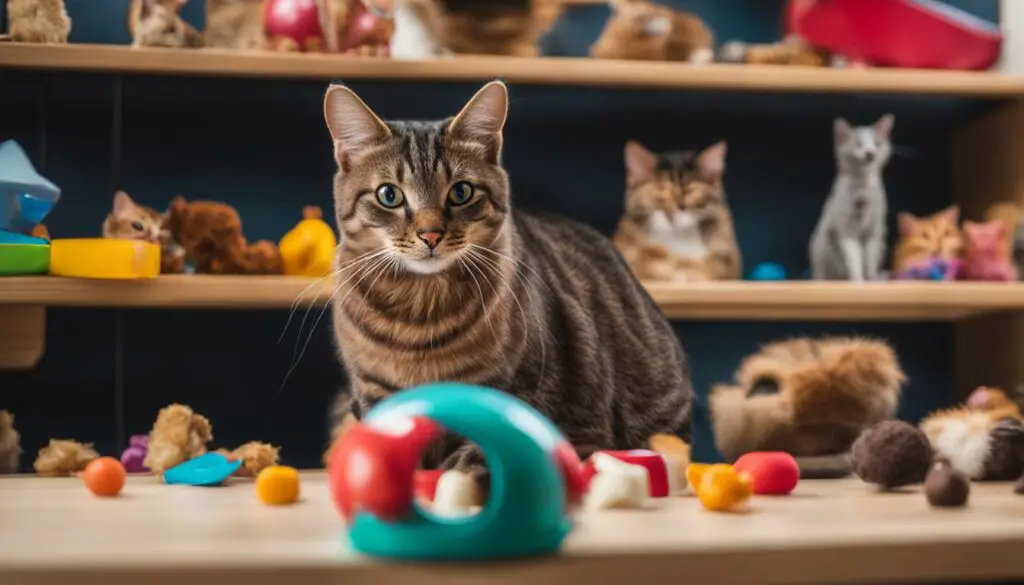
The Role of Health in Cat Behavior
When it comes to understanding a cat’s behavior, it is essential to consider their health as a significant factor. A cat’s physical well-being can have a profound impact on their behavior, including aggression. Medical issues can often be the underlying cause of a cat’s anger or frustration. Therefore, regular veterinary care and addressing any potential health problems are crucial for maintaining a healthy cat-human relationship.
Certain medical conditions can lead to changes in behavior, such as pain, discomfort, or hormonal imbalances. Cats may become aggressive as a result of these underlying issues. It is important to observe your cat’s behavior closely and look for any signs of physical distress. If you notice any unusual symptoms or changes in behavior, it is recommended to consult with a veterinarian for a thorough examination and appropriate treatment.
Common Medical Causes of Cat Aggression
There are several medical conditions that can contribute to cat aggression. These include:
- Pain or discomfort from injuries, arthritis, or dental problems
- Urinary tract infections or other urinary issues
- Hormonal imbalances, such as hyperthyroidism
- Neurological disorders
By addressing the underlying health issues, many cats experience a significant improvement in their behavior. Veterinary care is essential not only for their physical well-being but also for maintaining a harmonious and peaceful environment in your home.
| Medical Conditions | Symptoms | Treatment |
|---|---|---|
| Pain or discomfort | Restlessness, aggression, changes in appetite | Pain management, medication, veterinary treatment |
| Urinary tract infections | Urinating outside the litter box, aggression during elimination | Antibiotics, veterinary treatment, dietary changes |
| Hormonal imbalances | Behavioral changes, aggression, excessive vocalization | Medication, hormone therapy, veterinary treatment |
| Neurological disorders | Uncharacteristic aggression, abnormal movements | Diagnosis, medication, veterinary treatment |
Conclusion
Being proactive about your cat’s health is essential for maintaining a peaceful and loving relationship. Regular veterinary check-ups, observing their behavior for any potential signs of distress, and addressing any medical issues promptly can contribute to a happier and less aggressive cat. Remember, a healthy cat is more likely to exhibit positive behaviors and enjoy a harmonious bond with their owner.
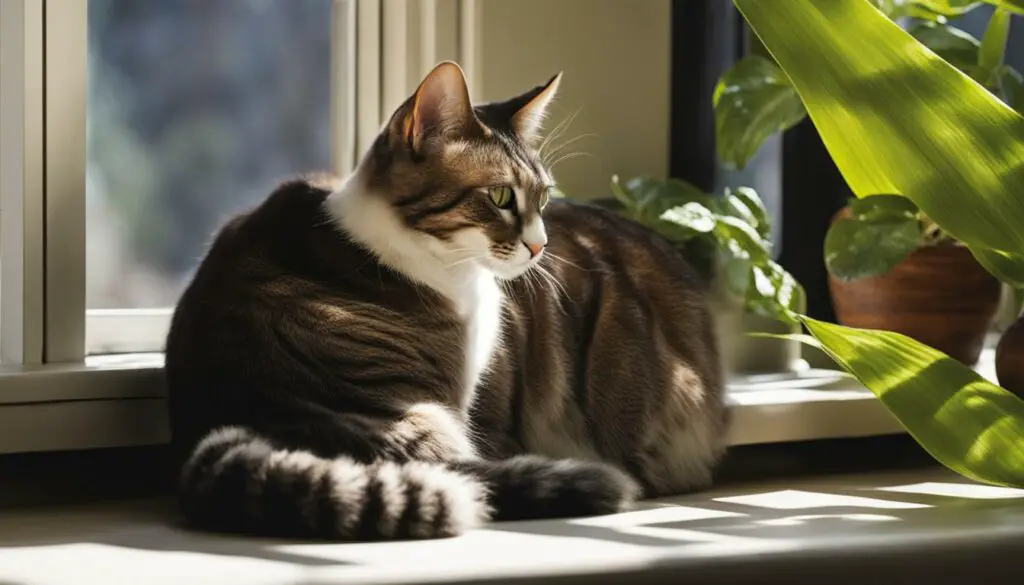
Providing a Safe and Enriching Environment
Creating a cat-friendly home is vital for ensuring your furry friend’s happiness and well-being. By enriching your cat’s environment, you can reduce stress and promote positive behavior. Here are some key tips:
Cat-Friendly Furniture
Invest in cat-friendly furniture that provides your feline with vertical spaces for climbing, resting, and observing their surroundings. Cat trees, shelves, and window perches are excellent options that cater to their natural instincts and provide them with a sense of security.
Interactive Toys
Engage your cat’s mind and body by providing them with interactive toys. Toys that stimulate their hunting instincts, such as puzzle feeders or wand toys, can keep them mentally and physically active. Rotate their toys regularly to keep them engaged and prevent boredom.
Scratching Posts
Offering suitable scratching posts is essential for a cat-friendly home. Cats have a natural instinct to scratch, which helps them stretch their muscles and maintain healthy claws. Provide both vertical and horizontal scratching surfaces, made of materials like sisal or cardboard, to give your cat variety and prevent them from damaging your furniture.
Quiet Retreats
Cats appreciate having quiet retreats where they can relax and feel secure. Create cozy hiding spots using cat beds, blankets, or cozy nooks where they can retreat when they need some alone time. These retreats can also serve as safe spaces during times of stress, such as when there are visitors or loud noises.

By implementing these cat-friendly strategies, you can reduce stress, promote positive behavior, and create a harmonious environment for your beloved feline companion.
Practicing Positive Reinforcement
When it comes to shaping a cat’s behavior, positive reinforcement is a powerful and effective technique. By rewarding good behavior and using treats and praise, you can encourage your cat to develop positive habits and strengthen the bond between you and your furry friend.
Positive reinforcement involves providing a reward when your cat exhibits the desired behavior. For example, if your cat uses the litter box consistently, you can offer a treat or praise as a reward. This positive association helps reinforce the behavior and encourages your cat to continue with it.
Using treats and praise as rewards can be particularly effective when training your cat to engage in appropriate scratching behavior. By providing a scratching post and rewarding your cat with treats or praise when they use it, you can redirect their natural instinct to scratch and protect your furniture at the same time.
Benefits of Positive Reinforcement
Practicing positive reinforcement has several benefits for both you and your cat. First and foremost, it creates a positive and nurturing environment, which fosters a strong and harmonious relationship. Your cat will associate you with pleasant experiences and rewards, leading to increased trust and cooperation.
Positive reinforcement also helps to build your cat’s confidence and self-esteem. When they receive praise and treats for their good behavior, they learn that their actions have a positive impact, boosting their confidence and encouraging them to continue exhibiting the desired behavior.
In contrast, punishment or negative reinforcement can have detrimental effects on your cat’s well-being and the relationship between you. It can lead to fear, anxiety, and a breakdown in trust. By focusing on positive reinforcement, you can maintain a loving and respectful connection with your cat while effectively shaping their behavior.
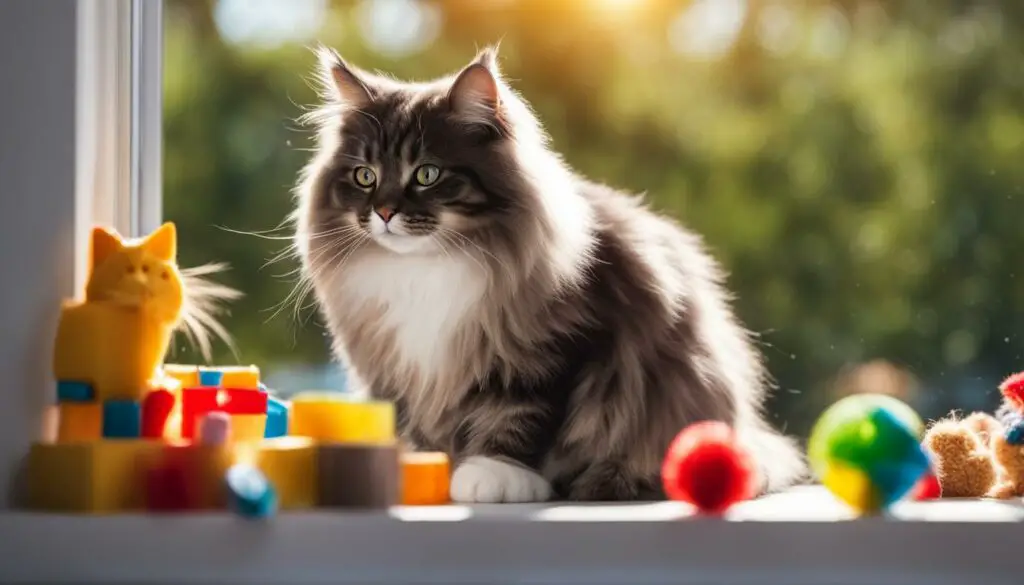
| Benefits of Positive Reinforcement | Examples |
|---|---|
| Strengthens the bond between you and your cat | Offering treats and praise when your cat exhibits good behavior |
| Builds your cat’s confidence and self-esteem | Rewarding your cat for using the scratching post |
| Creates a positive and nurturing environment | Praising your cat when they use the litter box consistently |
Seeking Professional Help
If your cat’s anger or aggression issues persist despite your best efforts, it may be beneficial to seek professional help. A cat behaviorist or a veterinarian with expertise in feline behavior can assess the situation, provide a comprehensive evaluation, and offer tailored advice and strategies to manage the behavior effectively.
Professional guidance is essential when dealing with complex behavioral issues in cats. A cat behaviorist is trained to understand and interpret feline behavior, and they can help identify the underlying causes of your cat’s anger. They will work closely with you to develop a personalized behavior modification plan that addresses the specific needs of your cat.
“Seeking professional help can make a significant difference in resolving your cat’s anger. A cat behaviorist has the knowledge and experience to guide you on how to communicate effectively with your cat, modify their behavior, and create a harmonious environment for both of you.”
Veterinary advice is also important when dealing with cat aggression. A veterinarian can conduct a thorough examination to rule out any possible medical causes for your cat’s behavior. They can provide treatment for any underlying health issues and offer guidance on how to manage your cat’s aggression in conjunction with behavior modification techniques.
Remember, seeking professional help is not a sign of failure as a cat owner. It is a proactive step towards understanding your cat’s needs and providing them with the best possible care. With the guidance of a cat behaviorist or veterinarian, you can improve your cat’s behavior, strengthen your bond, and create a happier and more harmonious home environment.

The Importance of Patience and Understanding
Building a strong relationship with your cat requires patience and understanding. Cats are unique creatures with their own personalities and needs, and it’s important to approach them with empathy and respect. By taking the time to observe and understand your cat’s behavior, you can build trust and create a harmonious bond.
Patience is key when it comes to dealing with a mad cat. It’s important to remember that their anger is often a reflection of their needs and emotions. Instead of reacting with frustration or punishment, try to remain calm and provide a safe and loving environment. This will help your cat feel secure and reduce the likelihood of aggressive behavior.
Understanding cat behavior is crucial in nurturing a healthy relationship. Cats communicate through various body language cues, such as tail movements, ear positions, and vocalizations. By paying close attention to these signals, you can gain valuable insights into your cat’s mood and emotional state. This understanding will enable you to respond appropriately and meet your cat’s needs.
The Power of Building Trust
Building trust with your cat is a gradual process that requires consistency and positive reinforcement. By establishing routines, providing a safe and enriching environment, and offering gentle affection, you can earn your cat’s trust over time. Avoid forcing interactions or using harsh methods, as these can damage the trust you’ve built. Remember, trust is the foundation of a strong cat-human relationship.
When your cat feels safe and loved, they are less likely to exhibit signs of anger. Patience and understanding are essential in navigating the complexities of feline behavior. By approaching your cat with empathy, observing their behavior, and building trust through positive reinforcement, you can cultivate a rewarding and fulfilling relationship with your feline companion.
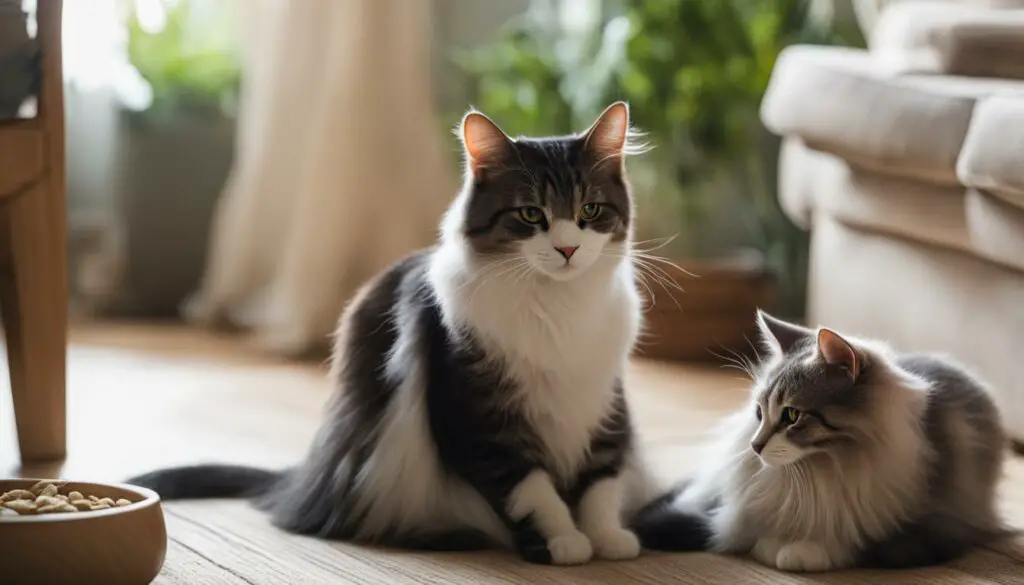
Maintaining a Calm and Stress-Free Environment
Creating a calm and stress-free environment is essential for the well-being of your cat. Cats are sensitive creatures, and environmental triggers can greatly impact their mood and behavior. By reducing cat stress and minimizing potential stressors, you can create a peaceful home that promotes a harmonious relationship with your feline companion.
Minimizing Environmental Triggers
Identifying and minimizing environmental triggers is the first step in creating a stress-free environment for your cat. Loud noises, sudden changes, and unfamiliar visitors can all cause anxiety and distress. By keeping the living space consistent and minimizing disruptions, you can help your cat feel safe and secure.
Providing Hiding Options
Allowing your cat to have hiding spots is important for reducing stress. Cats often seek out quiet, secluded areas when they feel overwhelmed or threatened. Providing hiding options, such as covered beds, cat trees with enclosed spaces, or dedicated hiding spots, gives your cat a safe space to retreat to when they need a break.
Creating a Relaxing Atmosphere
Cats are highly influenced by their surroundings, so creating a relaxing atmosphere is key. Soft lighting, calming music, and the use of pheromone diffusers can all help create a soothing environment. Additionally, offering comfortable resting places, such as cozy beds or blankets, can further promote relaxation and reduce stress.
By taking these steps to reduce stress and create a peaceful environment, you can help your cat feel more secure, content, and less likely to exhibit signs of anger or aggression. Remember, a calm and stress-free home is beneficial not only for your cat but also for your own well-being and the overall harmony of your household.
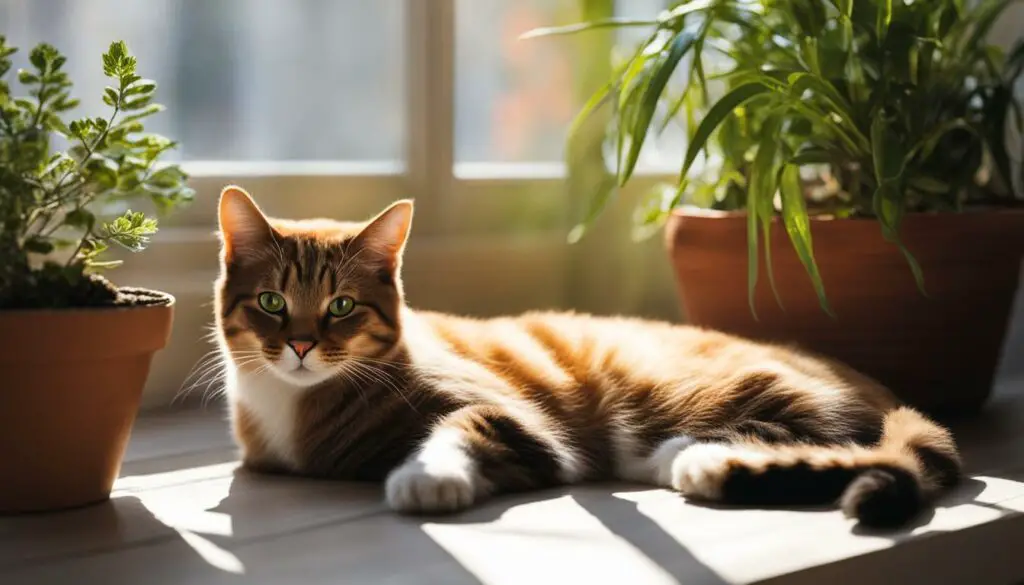
Building Trust Through Socialization
Introducing cats to new experiences and positive interactions with other animals is crucial for their socialization and overall well-being. Socializing cats from a young age helps them develop confidence, reduces fear, and promotes positive behavior. By gradually exposing them to different environments, people, and animals, you can ensure that your cat grows up to be well-adjusted and friendly.
One effective way to socialize your cat is to provide controlled interactions with other animals. This can be done by gradually introducing them to well-behaved and vaccinated cats or dogs in a neutral and supervised environment. Start with short and supervised meetings, allowing them to become familiar with each other’s scents and presence. Over time, increase the duration and frequency of these interactions, always observing their body language and making sure they are comfortable.
A vital aspect of socialization is exposing your cat to new experiences. This can include introducing them to various stimuli such as different sounds, objects, and surfaces. Gradually exposing them to these stimuli in a positive and controlled manner helps reduce fear and anxiety. Encourage curiosity by using interactive toys, providing scratching posts, and creating safe hiding spots for them to explore.
Remember, patience is key when socializing cats. Each cat has its own unique personality and may require different amounts of time to adjust to new experiences and interactions. Be consistent, reward positive behavior with treats and praise, and allow your cat to set the pace. By prioritizing socialization, you can build trust with your cat and ensure they are comfortable and well-adjusted in various social settings.
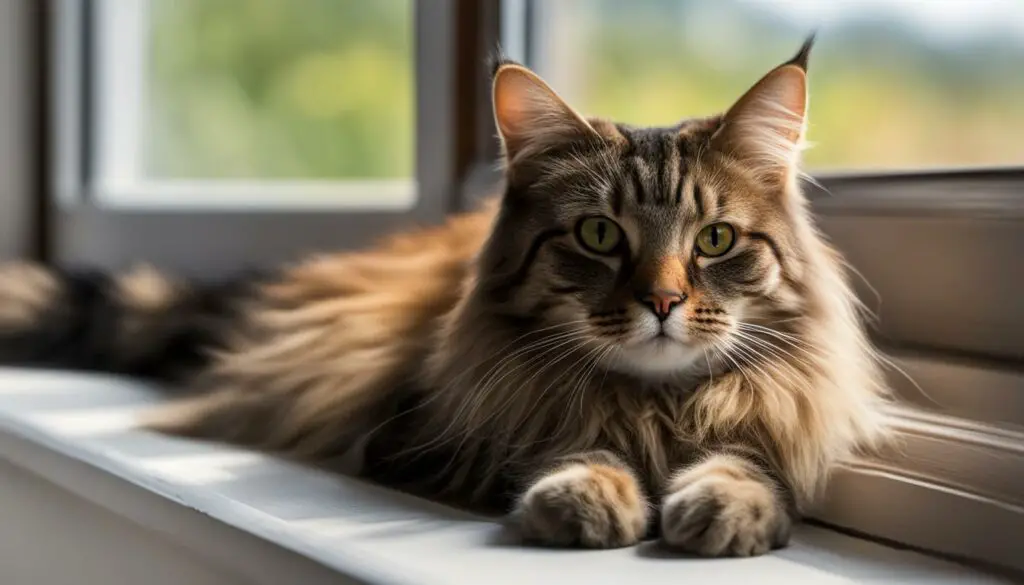
Benefits of Socialization for Cats
- Reduces fear and anxiety
- Promotes positive behavior
- Helps cats adjust to new experiences
- Builds confidence and trust
- Enhances their overall well-being
By investing time and effort into socializing your cat, you are laying the foundation for a happy and well-adjusted companion. Socialized cats are more likely to form strong bonds with their owners and other animals, leading to a peaceful and harmonious home environment. Remember, socialization is an ongoing process that requires patience and consistency, but the rewards are well worth it.
Nurturing a Healthy Cat-Human Relationship
Building a strong bond with your cat is a rewarding experience that requires effort and understanding. By investing time and attention into nurturing your cat’s physical and emotional needs, you can strengthen the bond between you and your feline companion.
One way to enhance your cat-human relationship is by engaging in interactive play. Playing with your cat not only provides physical exercise but also stimulates their natural hunting instincts. Use toys that mimic prey and encourage your cat to chase, pounce, and bat. This interactive playtime not only strengthens the bond between you and your cat but also promotes a sense of fulfillment and contentment.
In addition to playtime, it’s essential to create a safe and comfortable environment for your cat. Provide them with cozy and secure spaces where they can retreat to when they need some alone time. Consider adding vertical spaces, such as cat trees or shelves, where your cat can climb and observe their surroundings. These vertical spaces not only offer enrichment but also help satisfy your cat’s natural desire to explore and perch up high.
Remember that each cat is unique, and nurturing a healthy cat-human relationship requires patience and understanding. Be attentive to your cat’s individual preferences, and offer them love, affection, and companionship. By investing time and effort into strengthening the bond with your cat, you can create a harmonious and fulfilling relationship that will bring joy to both of your lives.
Conclusion
In conclusion, understanding and addressing a cat’s anger is an essential aspect of being a responsible cat owner. By observing their behavior, we can decipher their emotions and cater to their needs effectively. Building a strong bond with our cats through quality time, affection, and play can significantly reduce the likelihood of them becoming mad or upset.
By paying attention to feline body language, we can better interpret their cues and respond accordingly. Recognizing the warning signs of cat anger, such as aggression or avoidance, allows us to diffuse potential conflicts and create a more peaceful environment.
Identifying the potential triggers of cat anger, such as fear, discomfort, or lack of socialization, enables us to address the underlying issues and prevent future outbursts. Through behavior modification techniques, positive reinforcement, and seeking professional help when necessary, we can manage and improve their behavior effectively.
Overall, it is crucial to be patient, understanding, and consistent in our interactions with our feline companions. By providing a safe, enriching, and stress-free environment, we can nurture a healthy and fulfilling relationship with our cats, where anger is replaced with trust, love, and harmony.
FAQ
How can I tell if my cat is mad at me?
Cats may display signs of aggression, such as hissing, growling, swatting, scratching, or biting, when they are mad or upset. Additionally, they may also exhibit avoidance behaviors.
What are the common triggers for cat anger?
Cats can become mad or aggressive due to various reasons, including perceived threats to their territory, fear or anxiety, pain or discomfort, lack of socialization, or previous negative experiences.
How can I address my cat’s anger and aggression?
Behavior modification techniques, such as providing appropriate outlets for energy, positive reinforcement training, using interactive toys, and creating a safe and enriching environment, can be effective in managing and addressing cat aggression.
Can cat aggression be linked to health issues?
Yes, cat aggression can sometimes be linked to underlying health issues. Pain, discomfort, illness, or hormonal imbalances can contribute to changes in behavior, including aggression.
When should I seek professional help for my cat’s anger?
If your cat’s anger or aggression issues persist despite your best efforts, it may be beneficial to seek professional help from a cat behaviorist or a veterinarian with expertise in feline behavior. They can assess the situation and offer tailored advice and strategies to manage the behavior effectively.
How can I build trust and a positive relationship with my cat?
Building a strong and healthy cat-human relationship requires patience, empathy, and consistent care. Spending quality time together, meeting your cat’s physical and emotional needs, and providing a safe and loving environment are essential for nurturing a healthy connection.








